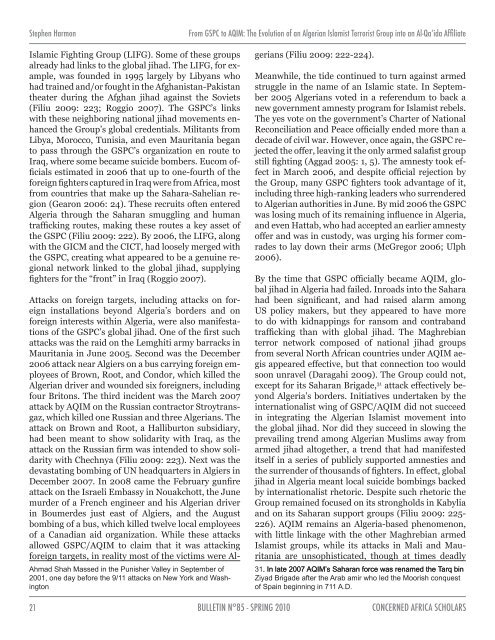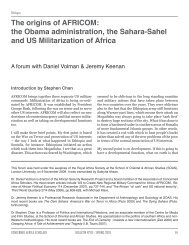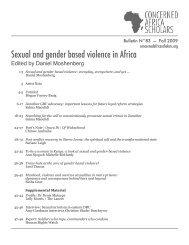Western Sahara and the United States' geographical imaginings
Western Sahara and the United States' geographical imaginings
Western Sahara and the United States' geographical imaginings
Create successful ePaper yourself
Turn your PDF publications into a flip-book with our unique Google optimized e-Paper software.
Stephen Harmon From GSPC to AQIM: The Evolution of an Algerian Islamist Terrorist Group into an Al-Qa‘ida Affiliate<br />
Islamic Fighting Group (LIFG). Some of <strong>the</strong>se groups<br />
already had links to <strong>the</strong> global jihad. The LIFG, for example,<br />
was founded in 1995 largely by Libyans who<br />
had trained <strong>and</strong>/or fought in <strong>the</strong> Afghanistan-Pakistan<br />
<strong>the</strong>ater during <strong>the</strong> Afghan jihad against <strong>the</strong> Soviets<br />
(Filiu 2009: 223; Roggio 2007). The GSPC’s links<br />
with <strong>the</strong>se neighboring national jihad movements enhanced<br />
<strong>the</strong> Group’s global credentials. Militants from<br />
Libya, Morocco, Tunisia, <strong>and</strong> even Mauritania began<br />
to pass through <strong>the</strong> GSPC’s organization en route to<br />
Iraq, where some became suicide bombers. Eucom officials<br />
estimated in 2006 that up to one-fourth of <strong>the</strong><br />
foreign fighters captured in Iraq were from Africa, most<br />
from countries that make up <strong>the</strong> <strong>Sahara</strong>-Sahelian region<br />
(Gearon 2006: 24). These recruits often entered<br />
Algeria through <strong>the</strong> <strong>Sahara</strong>n smuggling <strong>and</strong> human<br />
trafficking routes, making <strong>the</strong>se routes a key asset of<br />
<strong>the</strong> GSPC (Filiu 2009: 222). By 2006, <strong>the</strong> LIFG, along<br />
with <strong>the</strong> GICM <strong>and</strong> <strong>the</strong> CICT, had loosely merged with<br />
<strong>the</strong> GSPC, creating what appeared to be a genuine regional<br />
network linked to <strong>the</strong> global jihad, supplying<br />
fighters for <strong>the</strong> “front” in Iraq (Roggio 2007).<br />
Attacks on foreign targets, including attacks on foreign<br />
installations beyond Algeria’s borders <strong>and</strong> on<br />
foreign interests within Algeria, were also manifestations<br />
of <strong>the</strong> GSPC’s global jihad. One of <strong>the</strong> first such<br />
attacks was <strong>the</strong> raid on <strong>the</strong> Lemghiti army barracks in<br />
Mauritania in June 2005. Second was <strong>the</strong> December<br />
2006 attack near Algiers on a bus carrying foreign employees<br />
of Brown, Root, <strong>and</strong> Condor, which killed <strong>the</strong><br />
Algerian driver <strong>and</strong> wounded six foreigners, including<br />
four Britons. The third incident was <strong>the</strong> March 2007<br />
attack by AQIM on <strong>the</strong> Russian contractor Stroytransgaz,<br />
which killed one Russian <strong>and</strong> three Algerians. The<br />
attack on Brown <strong>and</strong> Root, a Halliburton subsidiary,<br />
had been meant to show solidarity with Iraq, as <strong>the</strong><br />
attack on <strong>the</strong> Russian firm was intended to show solidarity<br />
with Chechnya (Filiu 2009: 223). Next was <strong>the</strong><br />
devastating bombing of UN headquarters in Algiers in<br />
December 2007. In 2008 came <strong>the</strong> February gunfire<br />
attack on <strong>the</strong> Israeli Embassy in Nouakchott, <strong>the</strong> June<br />
murder of a French engineer <strong>and</strong> his Algerian driver<br />
in Boumerdes just east of Algiers, <strong>and</strong> <strong>the</strong> August<br />
bombing of a bus, which killed twelve local employees<br />
of a Canadian aid organization. While <strong>the</strong>se attacks<br />
allowed GSPC/AQIM to claim that it was attacking<br />
foreign targets, in reality most of <strong>the</strong> victims were Al-<br />
A��m�� S����� M�������� �� ����� P���������� ������y �� S��p���mb��� ��<br />
00 , ���� ��y b������� ����� 9/ �����k�� �� N��w Y��k ��� W������<br />
������<br />
21<br />
BULLETIN N°85 - SPRING 2010<br />
gerians (Filiu 2009: 222-224).<br />
Meanwhile, <strong>the</strong> tide continued to turn against armed<br />
struggle in <strong>the</strong> name of an Islamic state. In September<br />
2005 Algerians voted in a referendum to back a<br />
new government amnesty program for Islamist rebels.<br />
The yes vote on <strong>the</strong> government’s Charter of National<br />
Reconciliation <strong>and</strong> Peace officially ended more than a<br />
decade of civil war. However, once again, <strong>the</strong> GSPC rejected<br />
<strong>the</strong> offer, leaving it <strong>the</strong> only armed salafist group<br />
still fighting (Aggad 2005: 1, 5). The amnesty took effect<br />
in March 2006, <strong>and</strong> despite official rejection by<br />
<strong>the</strong> Group, many GSPC fighters took advantage of it,<br />
including three high-ranking leaders who surrendered<br />
to Algerian authorities in June. By mid 2006 <strong>the</strong> GSPC<br />
was losing much of its remaining influence in Algeria,<br />
<strong>and</strong> even Hattab, who had accepted an earlier amnesty<br />
offer <strong>and</strong> was in custody, was urging his former comrades<br />
to lay down <strong>the</strong>ir arms (McGregor 2006; Ulph<br />
2006).<br />
By <strong>the</strong> time that GSPC officially became AQIM, global<br />
jihad in Algeria had failed. Inroads into <strong>the</strong> <strong>Sahara</strong><br />
had been significant, <strong>and</strong> had raised alarm among<br />
US policy makers, but <strong>the</strong>y appeared to have more<br />
to do with kidnappings for ransom <strong>and</strong> contrab<strong>and</strong><br />
trafficking than with global jihad. The Maghrebian<br />
terror network composed of national jihad groups<br />
from several North African countries under AQIM aegis<br />
appeared effective, but that connection too would<br />
soon unravel (Daragahi 2009). The Group could not,<br />
except for its <strong>Sahara</strong>n Brigade, 31 attack effectively beyond<br />
Algeria’s borders. Initiatives undertaken by <strong>the</strong><br />
internationalist wing of GSPC/AQIM did not succeed<br />
in integrating <strong>the</strong> Algerian Islamist movement into<br />
<strong>the</strong> global jihad. Nor did <strong>the</strong>y succeed in slowing <strong>the</strong><br />
prevailing trend among Algerian Muslims away from<br />
armed jihad altoge<strong>the</strong>r, a trend that had manifested<br />
itself in a series of publicly supported amnesties <strong>and</strong><br />
<strong>the</strong> surrender of thous<strong>and</strong>s of fighters. In effect, global<br />
jihad in Algeria meant local suicide bombings backed<br />
by internationalist rhetoric. Despite such rhetoric <strong>the</strong><br />
Group remained focused on its strongholds in Kabylia<br />
<strong>and</strong> on its <strong>Sahara</strong>n support groups (Filiu 2009: 225-<br />
226). AQIM remains an Algeria-based phenomenon,<br />
with little linkage with <strong>the</strong> o<strong>the</strong>r Maghrebian armed<br />
Islamist groups, while its attacks in Mali <strong>and</strong> Mauritania<br />
are unsophisticated, though at times deadly<br />
3 . I� I� ����� ����� 00 A�IM’�� A�IM’�� S������� S������� ������ ������ w��� w��� �����m��� �����m��� ����� ����� T��q T��q b�� b��<br />
��y�� B������� ������ ����� A��b �m�� w��� ���� ����� M�������� ���q������<br />
�� Sp��� b��������� �� A.�.<br />
CONCERNED AFRICA SCHOLARS




